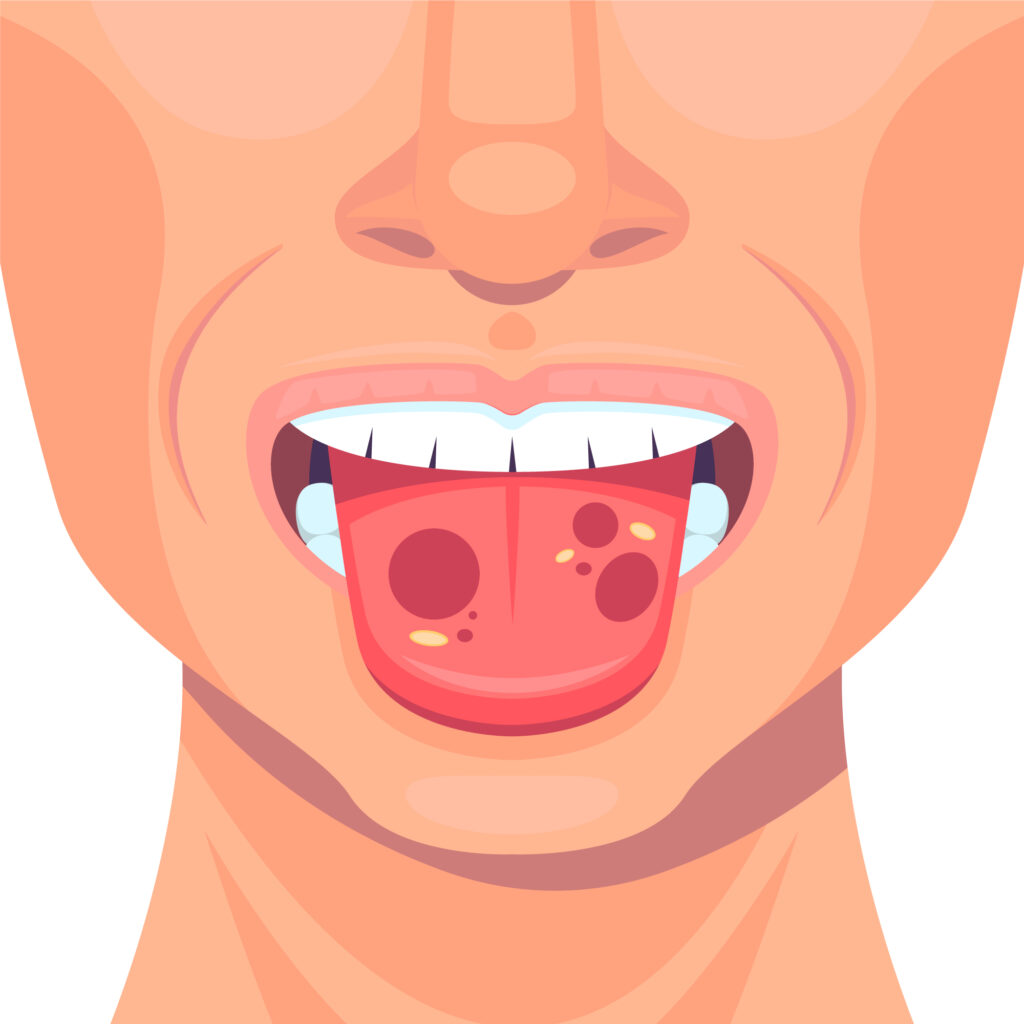
In this article
What is Geographic Tongue?
Geographic tongue, also known as benign migratory glossitis, is an inflammatory but harmless condition that affects the tongue’s surface. Normally, the tongue is covered with tiny, pinkish-white bumps called papillae, which are actually fine, hairlike structures. In the case of geographic tongue, patches on the tongue’s surface lose these papillae, resulting in smooth, red areas with slightly raised borders.
This condition earns its name because the patches resemble a map, often shifting from one area to another over time.
Symptoms of Geographic Tongue
Geographic tongue can present various symptoms, though some individuals may not experience any. Common signs include:
- Smooth, red, irregularly shaped patches on the top or sides of the tongue that may resemble sores.
- Frequent changes in the location, size, and shape of these patches.
- Pain or a burning sensation, particularly when consuming spicy, acidic, or sweet foods.
Duration and Recurrence
Geographic tongue can persist for days, months, or even years. The condition often resolves on its own, but it can reappear intermittently.
When to Seek Medical Advice
Most individuals with geographic tongue do not require treatment due to the absence of symptoms. However, if you experience discomfort or suspect an infection, it is advisable to consult a doctor or dentist. In some cases, medication may be prescribed to alleviate symptoms.
Possible Causes
The exact cause of geographic tongue remains unknown, and there is no known prevention method. Some research indicates a possible association between geographic tongue and other conditions like psoriasis, a skin disorder marked by itchy, scaly patches. Additional studies are required to further investigate these potential links.
Risk Factors
Several factors may increase the likelihood of developing geographic tongue:
- Family History: Genetic predisposition can play a role, as geographic tongue often runs in families.
- Fissured Tongue: Individuals with geographic tongue frequently have fissured tongue, a condition characterized by deep grooves on the tongue’s surface.
Complications and Concerns
While geographic tongue is harmless and does not pose any serious health risks or long-term complications, it can cause discomfort and anxiety. The unusual appearance of the tongue can be embarrassing, making it hard to believe that the condition is benign.
Diagnosis
A physician or dentist typically diagnoses geographic tongue through a visual examination and symptom review. The diagnostic process may include:
- Using a lighted instrument to inspect the tongue and mouth.
- Asking the patient to move their tongue to different positions.
- Gently touching the tongue to check for tenderness or unusual changes in texture.
- Checking for signs of infection, such as fever or swollen lymph nodes.
Because some symptoms of geographic tongue can resemble other conditions like oral lichen planus, differential diagnosis may be necessary to rule out other issues.
Treatment Options
Geographic tongue usually does not require medical treatment. However, for those experiencing pain or sensitivity, several management options are available:
- Over-the-counter pain relievers.
- Mouth rinses that numb the area.
- Antihistamine mouth rinses to reduce swelling.
- Corticosteroid ointments or rinses for managing inflammation.
- Vitamin B or zinc supplements.
- Medications for fungal infections, if present.
Since geographic tongue tends to resolve on its own, it can be difficult to determine the effectiveness of these treatments.
Lifestyle and Home Remedies
To manage symptoms, individuals with geographic tongue should avoid substances that can exacerbate discomfort. These include:
- Spicy foods.
- Acidic foods and beverages.
- Alcohol.
- Tobacco.
Preparing for a Medical Appointment
If you are concerned about the appearance of your tongue, scheduling an appointment with your doctor or dentist can be beneficial. Preparing questions in advance can help you make the most of your visit. Consider asking:
- What is causing the appearance of my tongue?
- Are there any other possible causes?
- How long will this condition last?
- What treatments are available?
- Are there any home remedies to ease my discomfort?
- What should I do if my symptoms return?
What to Expect from Your Doctor
During your appointment, your doctor may ask questions such as:
- When did the patches first appear?
- Have the appearance or location of the patches changed?
- Have you experienced other red patches or sores in your mouth?
- Are there any foods or substances that trigger discomfort?
- Have you noticed any unrelated symptoms, such as fever?
Being prepared with detailed information will help your doctor provide the best possible care.
The Takeaway
Geographic tongue is a benign condition that, while visually striking, poses no serious health risks. Understanding its symptoms, risk factors, and management strategies can help alleviate concerns and ensure proper care. If you experience discomfort or are unsure about your symptoms, consulting a healthcare professional can provide reassurance and guidance
A Quick Review
Geographic tongue is a harmless inflammatory condition affecting the tongue’s surface, resulting in smooth, red patches that shift locations. It doesn’t cause serious health issues but can lead to discomfort, especially when eating spicy or acidic foods. Diagnosis is often straightforward, with treatment focusing on symptom management if needed
FAQS
What causes geographic tongue?
The exact cause is unknown, but genetic factors and conditions like psoriasis may play a role.
Is geographic tongue contagious?
No, geographic tongue is not contagious and does not spread from person to person.
Can geographic tongue lead to other health problems?
Geographic tongue is generally harmless and does not lead to serious health issues or long-term complications.
How is geographic tongue diagnosed?
Diagnosis is typically made by a visual examination of the tongue and a review of symptoms by a healthcare professional.












